Text

Judy Alden from the two-story series The Adventures Jack and Judy Alden, is on the face of it, an unlikely “dominant” comic book heroine. She and her brother, aged about 16, live in a rather British-like wartime American world of jolly hockey sticks and ripping adventures. However, the indomitable Judy’s toughness and resilience is on full display in the story featured, with some cracking action-girl dialogue. In the first page Judy takes on the crazed villain, Archibald Bach, single handedly after the boys have been flattened. “Hey! Where are you going, mister?” she declares before tripping him up and then fearlesssly pursues him with the ironic words, “Wait a minute, I have a friend who wants to meet you!” Unfortunately after that, the “meddling girl” is thrown to the ground by the baddie (well, he is twice her size) before he makes his escape.

Later Jack and Judy continue the pursuit of Bach, but this time by speed boat along a rapidly flowing river. Jack checks Judy is up for the chase, and her answer is pure gold: “Full speed ahead, skipper, we simply must capture that terrible man!” combining female determination with a touch of patronising snobbery toward the scoundrel.
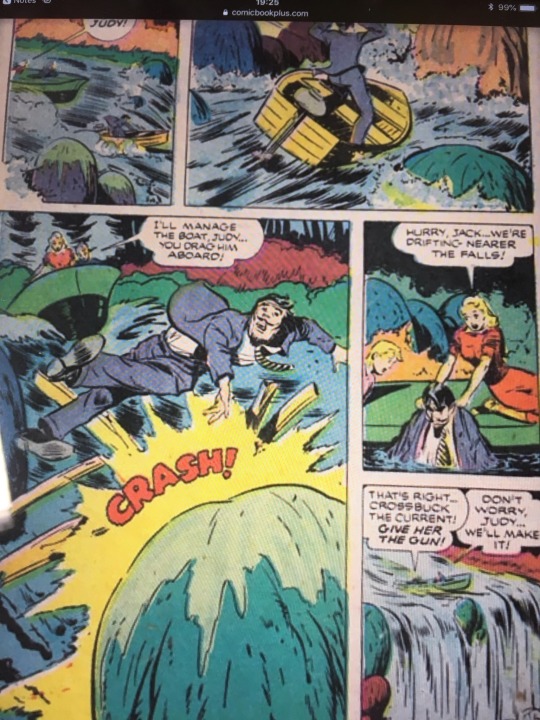
And as the next page reveals, it is indeed Judy who captures the ‘terrible man”. When he loses control of his boat in the rapids, it is actually Judy who rescues the fugitive and hauls him aboard her and Jack’s boat, a bedraggled prisoner.
And the denouement is in the final page below. Judy has the demoralised captive securely tied up (and gagged too for some reason!) next to her in the boat and when relieved former damsel in distress who had been terrorised by Bach, greets the victors with thanks, Judy’s reply is effortlessly upper class trash-talking: “Forget it! We had fun catching him!” Judy later helps tie her captive to a chair while Jack calls the state patrol on his ham radio to come and collect him. There is even time for a swim at the end: all in a day’s work for the adventurous teen, clearly. Judy therefore deserves a mention in this blog, I think.
These pages are from the Judy and Jack story Adventure on Silver Lake, which appeared in CMO Comics #2 (1942)
Source: comicbookplus

#CMO Comics#Judy alden#Jack and Judy alden#golden age comic book heroines#golden age of comics#adventure and peril
4 notes
·
View notes
Text
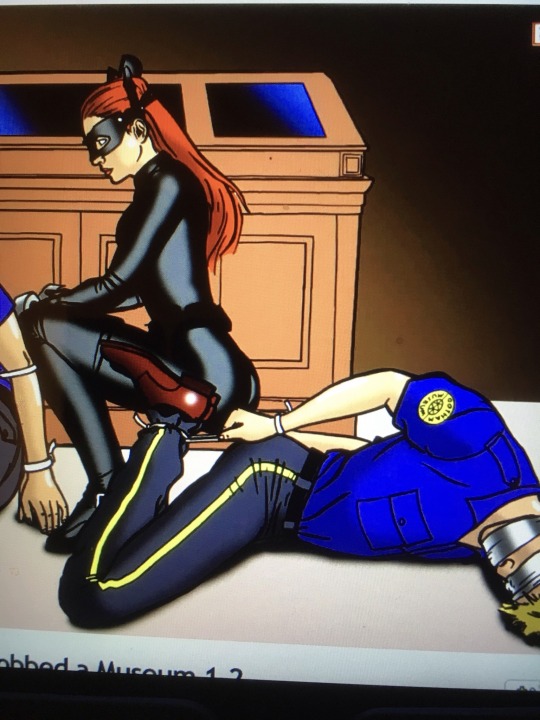
A Female Cat Burglar Robs A Museum
‘More haste and less speed,’ Selina reminded herself as she patiently pulled a length of duct tape free in order to blindfold and gag the second of the two unconscious security guards she had overpowered in the Egyptian Artefacts section of the Gotham Museum. The cute blonde captive, securely hogtied with zipties, groaned slightly beneath his gag. “Don’t worry, honey,” the cat burglar reassured the stirring man, “all you’ll have is a slight headache. So much more preferable than the nausea, blurred vision and two nights in hospital you guys had to endure in the old days after I had knocked you cold! So much easier since they started putting etorphine spray on the black market!”
Once both her “mmmphing”captives were securely incapacitated, Selina stood, stretched feline-like and headed towards the Nefertiti On Tour sign. “Now there was a girl after my own heart!” the leather clad burglar laughed to herself. “Such pretty jewels too!”
I have lost the detail of the artist but I believe they posted this fetching image on Deviant Art. If anyone knows the artist, please let me know and I will credit them.
6 notes
·
View notes
Text

Tiger Girl In Action
The ever versatile Tiger Girl captures a conman hypnotist posing as a “voodoo master” with her ‘stronger spell’ and the help of a tiger called Togara!
Source: comicbookplus
#women in comics#strong woman#golden age of comics#golden age comic book heroines#jungle women#tiger girl#jungle adventures#fight comics
4 notes
·
View notes
Text

Tiger Girl was an Indian princess version of Sheena who appeared continuously for nearly a decade in Fight Comics, published by the heroine-friendly Fiction House, between 1944 and 1954, the year of the publishing house’s demise. Apart from the setting of a never-never “lost kingdom” in a non-specific part of Africa, there was little to distinguish Tiger Girl from her East African inspiration, other than the lethal-looking bullwhip she wielded in order to subdue her enemies and her two “pet” tigers , the aptly named Scimitar and Spear, whom she deployed to protect her “domain” from evil intruders and exploiters.
Tiger Girl’s back story was interesting in that she was the daughter of an Indian aristocrat named Rajah Vishnu and an unnamed Irish mother. This actually made her the only mixed race jungle woman of the Golden Age but inevitably, and in true Sheena homage style, she was inexplicably depicted with flowing golden tresses (although interestingly, in her earlier adventures she is shown as a redhead). Her father brought her to Africa, somehow founded a realm there, which his daughter took to patrolling in adulthood in true jungle girl fashion, complete with tiger skin bikini. Tiger Girl, like Sheena, tended to the more “savage’ aspect of the jungle heroine’s nature, frequently not taking her loathsome enemies alive to face justice, but allowing the brutal laws of the jungle to run their course. Derivative Tiger Girl may have been, but she was a popular storyline, indicated by the title’s longevity and by the fact she was Fight Comic’s cover character for much of her run.
In the page featured, a crazed scientist named Remington, attempting to take over Tiger Girl’s kingdom with an army of intelligent apes, is defeated by a combination of the jungle girl’s whip, her two tigers and a friendly local tribe. We are assured the vanquished Remington “shall pay!” but what that means is left to our imagination.
Tiger Girl was the creation of artist Robert Hayward Webb, who also worked on Sheena. The writers of her stories are unknown. The page featured is from the Tiger Girl adventure in Fight Comics #80 (May 1952).
Sources: Bleeding Cool website and comicbookplus
#women in comics#tiger girl#golden age comic book heroines#golden age of comics#fiction house#fight comics#jungle heroines#jungle adventure
7 notes
·
View notes
Text
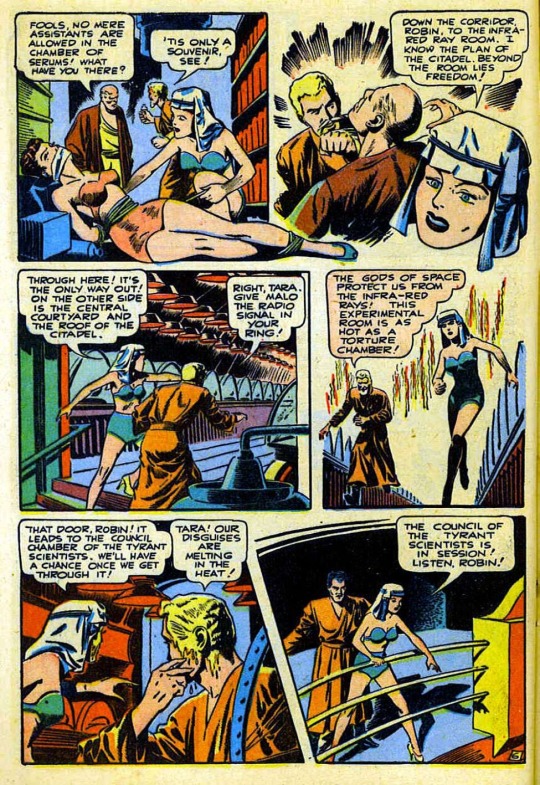
Tara, Outlaw of the Universe, was unusual for a Golden Age heroine in that she led an outlaw gang of men, Robin Hood-style, in an effort to save earth from any number of monsters, pirates and aliens looking to destroy it. Tara’s outlaw status, together with that of her sidekicks, Robin and Malo, occurred when they were forced to provoke war between Earth and Mars when the Martian ambassador freed the evil pirate Atto, whom Tara had captured and had brought back to earth to face justice. Although her adventures were action-packed, Tara enjoyed a run of just six comics, the last five issues of Wonder Comics and her final jaunt in a single story in Thrilling Comics. Basically Tara and her friends were an interplanetary version of Pirates of the Caribbean, but despite the silliness, the stories are great fun, and Tara herself a resourceful leader of men.
In the page featured a disguised Tara and Robin are on Mars, hunting for a serum to cure a deadly virus unleashed on Earth by a dancer named Leela who turns out to be a Martian spy. They really should have made an RKO TV series out of Tara’s adventures.
This page is from the Tara story The Death That Grew, published in Wonder Comics #20 (October 1948). Art was by Gene Fawcette.
Source: Darkworlds Quarterly website, March 2020 and comicbookplus
#women in comics#strong woman#wonder comics#Tara pirate of the universe#golden age comic book heroines#golden age of comics#space adventures
6 notes
·
View notes
Text

Sally O’Neil, Policewoman makes another appearance in this blog. I have covered Sally’s back story previously- a tough young woman from a police family, determined to make it first as a uniformed beat copper and then as a detective in a New York PD not at all sure it wanted to welcome female officers on equal terms in the early 1940s. The reason Sally eventually earns acceptance is due to her fighting skill, courage and excellent detecting work, enabling her to crack cases and bring bad guys to justice with a minimum of male assistance. Sally also had no problem going undercover solo if it meant catching criminals, as illustrated in this page where, disguised as a cigarette girl and dressed in a ball gown, the dauntless female police officer single-handedly captures three gangsters, with the aid of a car window, a spanner and two spare tyres. Her response to the concerned male officers who arrive belatedly to her rescue, is brilliant: “I’m all right! But my boyfriends aren’t so comfortable!” This adventure’s dynamism and action is helped by the excellent artwork by A Bryant, rendering a truly beautiful Sally in the final panel.
This page is from the Sally O’Neil, Policewoman story Mass Murder, which appeared in National Comics #30 (March 1943).
Source: comicbookplus
5 notes
·
View notes
Text
A great rendering of one of the most intriguing, intelligent and sexy female members of the Legion of Super Heroes.

Saturn Girl
206 notes
·
View notes
Text
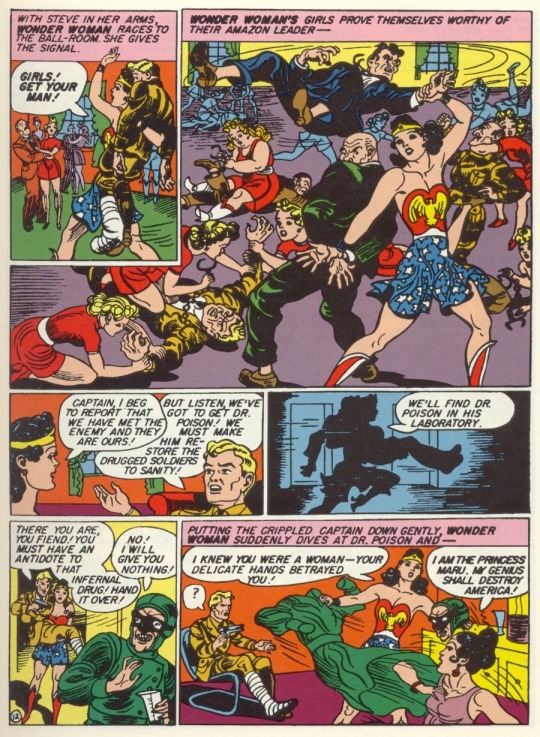
The Golden Age Wonder Woman in impressive action. There are so many killer lines on this page: “Girls! Get your man!”; “There you are, you fiend!”; “I knew you were a woman - your delicate hands betrayed you!”; “My genius shall destroy America!” It also boasts a villainess called Dr Poison…
Drama, female empowerment, sexual stereotyping, fiendish villains - this story has it all! They just don’t write stuff like this anymore. Is that good or bad…?
Source: Sensation Comics #2 (February 1942).
4 notes
·
View notes
Text
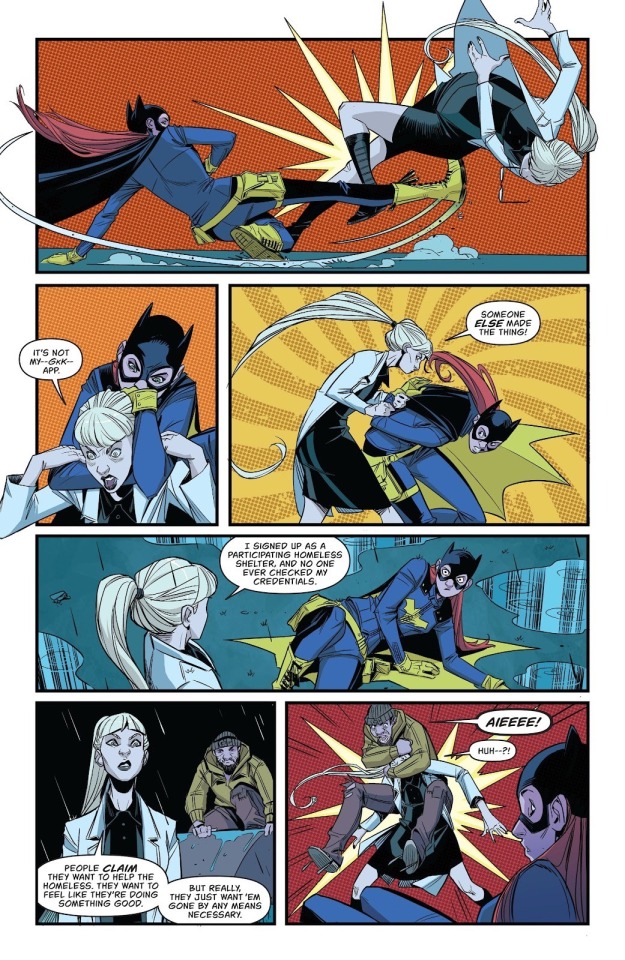
Sometimes even Batgirl needs a helping hand!

Batgirl Captures No 1
With thanks to a true heroine, Batgirlspain.
20 notes
·
View notes
Text

The immense Jill Trent Science Sleuth and partner Daisy Smythe in action once again. Despite the ladies’ undeniable technological brilliance and their extraordinary sleuthing skills, sometimes victory is won by rather more basic means. When their light ray fails to deter a tough villain who then resorts to gunplay, the enterprising Jill goes to the opposite end of the scale and confuses the bad guy by simply smashing a light bulb and plunging the room where she and her partner are being held into darkness. Then it is simply a matter of the outraged ladies disarming the loser and overpowering him (“Try to kill us, will you?” POW! SOK! “Oww! Help! Let me go!”). Suitably disheveled and with his hands bound behind his back, the sullen looking Arthur is later handed over to the cops by the science detectives - who explain everything to the lieutenant while exonerating the falsely accused Jack Benson into the bargain. I think this is one of the most satisfying endings to a Jill Trent adventure - containing detecting skills, “science”, old fashioned female fisticuffs and everything coming together at the end - with even a hint of trash talk from the triumphant Daisy!
Source: The Case of the Black Sheep Murder, Jill Trent Science Sleuth, Gwandaland Comics #943
#Jill Trent science sleuth#Daisy Smythe#women in comics#strong woman#man tied up by woman#golden age of comics#golden age comic book heroines#detective comics#woman detective#female sleuth
3 notes
·
View notes
Text

No one does illustrated female dominance better than Eric Stanton. Here, it seems a couple of working girls have got tired of being pushed around by their pimp. I think the girls are giving this hapless jerk a crash course in nylons aversion therapy: girl 1 is choking the guy out by wrapping her fishnet-clad legs around his neck, while girl 2 busily ties his ankles with a pair of pantyhose. He certainly doesn’t look like he is enjoying the experience of being wrapped up in female hosiery.
Whether it is friend or foe wielding the gun on the left is anyone’s guess…
5 notes
·
View notes
Text
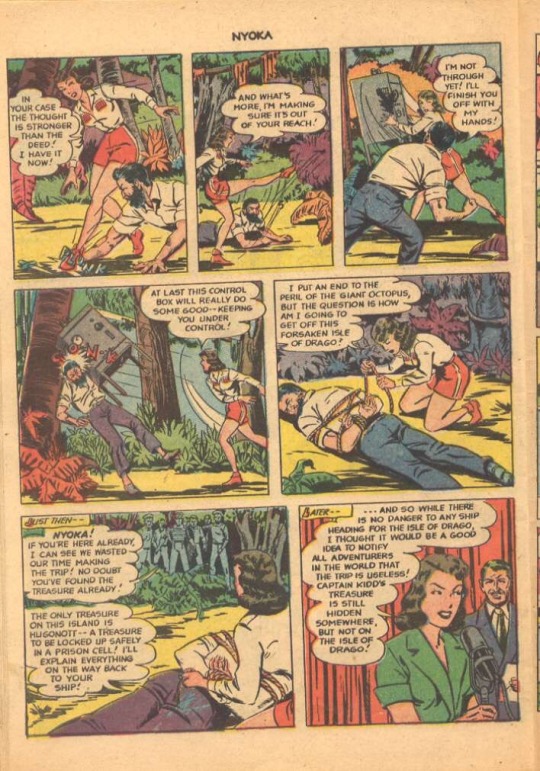
Nyoka the Jungle Girl is not my favourite jungle heroine to be honest. Lacking the primal and savage nature of Sheena or Tiger Girl; the untamed character of Cave Girl; the imperial hauteur of Camilla; the majestic beauty of Jann, or even the long-suffering feminism of Lorna, she was always too much of a goody two-shoes for me. Working with the colonial and military authorities to bring bad guys to justice, running an unlikely souvenir shop in the jungle, trapping animals for zoos and being a general smart alec, Nyoka rarely shows a rebellious spirit. Despite their regular cliff-hanger endings, the stories also often lacked the plot depth and intriguing story lines present in other jungle woman titles. Whereas as most of the genre depicted “native” peoples in a patronising light at best, the depiction of African characters in Nyoka was often openly racist.
However, despite frequently being cast in damsel in distress mode in her adventures and being “clonked” on the heads sufficient times to put her in a wheelchair, Nyoka had an extraordinary ability to turn the table on her opponents, often using her fists, or whatever came to hand. In the page above Nyoka, faced with the murderous treasure-hunting villain Hugonott, the jungle heroine disarms him with her heel and then subdues him by throwing a safe at him (like you do)! Nyoka’s unerring ability to win the day and enterprising means of capturing her foes, has to make her a regular character featured on this blog, whatever my doubts about her stories’ literary worth!
Source: comicbookplus
#women in comics#golden age of comics#strong women#nyoka#Nyoka the jungle girl#fawcett comics#golden age comic book heroines#jungle adventure#jungle woman captures the bad guys
4 notes
·
View notes
Text
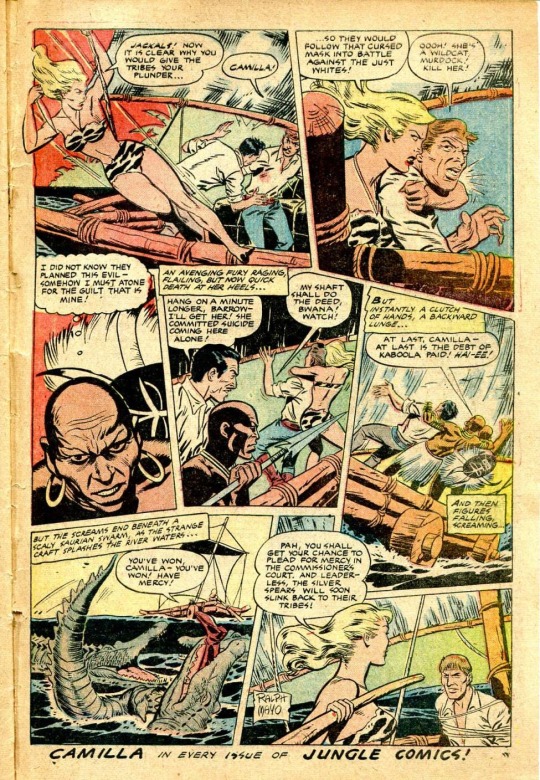
The drama in this final page of a Camilla the jungle queen adventure is first class. Against the odds a vengeful jungle heroine swings into action against a group of four male crooks seeking to escape with stolen tribal artefacts on a makeshift raft. The odds are actually too great for Camilla. Even as she attempts to overpower one of the bad guys, Murdock, the leader of the gang, backed up by a spearman, sneaks up on her in an attempt to murder the jungle woman. However the witch doctor Kaboola who had aided the thieves in their racial war plotting, mistaking their motives, intervenes and pulls both Murdock and his henchman into the river where all three will be devoured by the waiting crocodiles. The remaining baddie quickly surrenders to Camilla, begging for mercy, who lashes him to the mast of the raft. “Pah!” she tells her quailing captive before steering the raft back to shore to hand him over to the district commissioner.
Exciting story by Victor Ibsen, dynamic art by Ralph Mayo, violent jungle justice and a great scene of female dominance in the final panel- what more could you need?
The above page is from the story Ride With Me To Glory! and was published in Jungle Comics #142 (October 1951)
Source: comicbookplus
#women in comics#strong woman#man tied up by woman#golden age of comics#jungle heroines#golden age comic book heroines#jungle comics#Camilla queen of the jungle
3 notes
·
View notes
Text
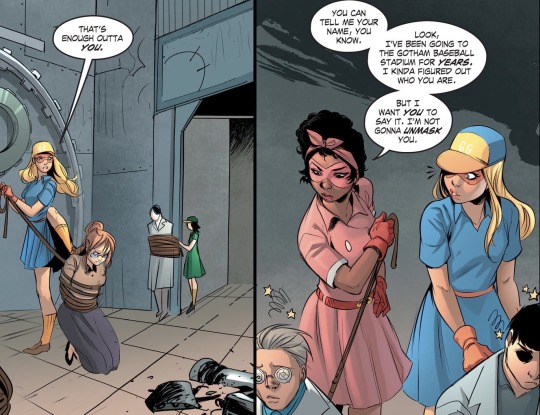
The Batgirls, were named not after the winged creatures of the night, but because they began as an all-female baseball team in wartime Gotham City, who branched out into vigilante crime fighting. The Girls are just some of a vast cast of heroines and villainessss aiding and abetting the Nazis who are busy securing both advanced technological and supernatural help to aid them in winning the war, featured in the 2015-2017 series DC Comics Bombshells. Apart from their athleticism and fighting prowess, with nods to their later 1960s namesake, the Batgirls also literally use their baseball bats as weapons when taking down street criminals, crooked politicians and, in this case, the owners of an orphanage who are using it as a front to develop Nazi weapons and to supply the Fatherland with child slave labour.
These panels are from DC Comics Bombshells #21 (2015). The series was inspired by a set of collectible statuettes depicting various DC Comics heroines designed by Ant Lucia. Marguerite Bennett wrote the series, supported by a number of different artists and, like Lucia’s original designs, gave the title a retro 1940s look. The Batgirls are perhaps something of a curiosity, but what’s not to love about an anti-Nazi baseball playing girl gang?
Source: ReadComicsOnline
6 notes
·
View notes
Text
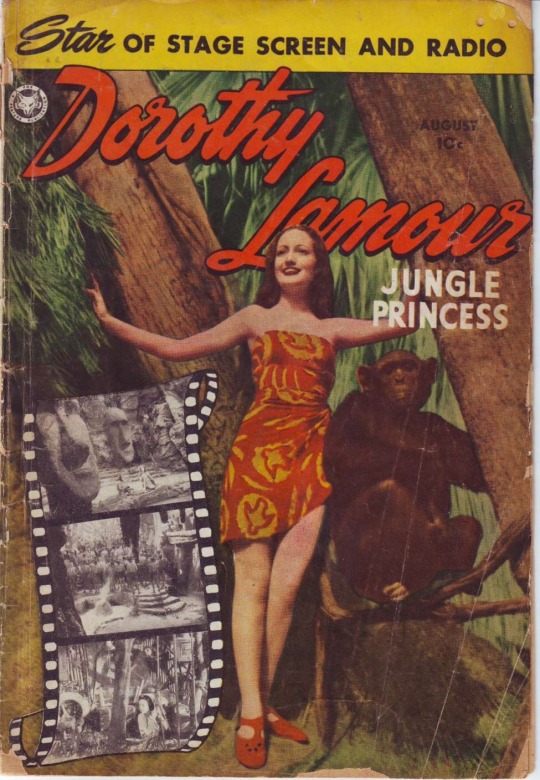
Perhaps one of the most curious of the Golden Age jungle heroine titles was the short-lived (it lasted precisely two issues) Dorothy Lamour, Jungle Princess, featuring the beautiful postwar actress and star of the “Road” movies with Bob Hope and Bing Crosby as a Sheena type character, based on her character in the 1936 movie The Jungle Princess, replete with an orphaned-in-the-jungle origin story. In truth, this was a thrown together title, exploiting the huge fame of Lamour at the time and featuring photographs on the covers of the two editions looking suitably alluring, clad in a jungle sarong. There were a total of nine short adventures crammed into the two issues of the Lamour title, but the brevity, both in storytelling and the rather dashed off art, shows when compared to the best adventures of Jann of the Jungle or Lorna the Jungle Queen. Dorothy Lamour, Jungle Princess’ two issues were published in June and August 1950.

In the page featured above, Dorothy foils a somewhat by-the-numbers villain named Brock who was seeking to steal a medicinal drug and murder the research scientist he was supposedly working for in order to sell it himself and make a fortune. Dorothy rather easily defeats Brock with a well-aimed slingshot and a swinging-on-the-vine double footed kick.
The story is entitled The Forgotten Safari and was written and illustrated by Wally Wood and possibly Harry Harrison. It appeared in Dorothy Lamour, Jungle Princess #2 (June 1950). The cover featured above is to Dorothy Lamour Jungle Princess #3 (August 1950). Confusingly I can find no trace of issue #1 from this title, although a cover was apparently designed for a fourth issue, which was never published.
Source: comicbookplus
#women in comics#jungle heroines#golden age comic book heroines#Dorothy lamour jungle princess#dorothy lamour#the jungle princess
4 notes
·
View notes
Text
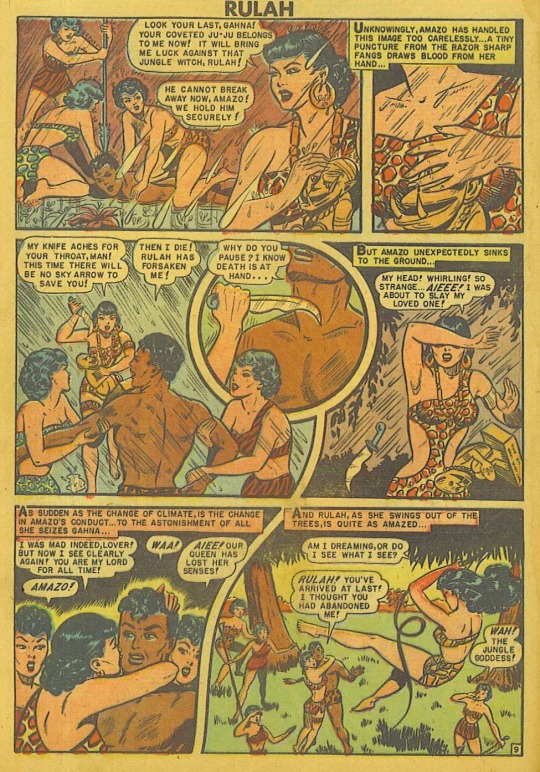
Alhough Rulah Jungle Goddess has featured quite recently in this blog, I felt obliged to post this page from an adventure entitled The Wondrous Jade Jungle-Ju, simply due to the extent of female dominance on display here. The story features the curiously named queen Amazo, whose female warriors terrorise the local tribes by sweeping down, plundering their villages and hauling captives off to a life of slavery. The unfortunate young medicine man Gahna, is initially kidnapped by the jungle amazons and made a slave. Amazo however is after his “ju-ju” jade idol with which she hopes to defeat Rulah and Gahna, despairing of being rescued by the jungle goddess, makes an ill-advised escape attempt only to be rather easily overpowered by his female captors. Then, held fast by two of the warriors, Amazo approaches him with a sacrificial dagger in order to slay him, only for the magic of the ju-ju idol to make the queen fall in love with her prisoner. Poor Gahna then has to fend of the smitten advances of the formerly homicidal Amazo until Rulah at last appears to save him. You could forgive the confused young man an exasperated cry of “Women!” under these circumstances!

The page featured is from Rulah Jungle Goddess #21 (December 1948).
Source: comicbookplus
#women in comics#Rulah jungle goddess#jungle heroines#jungle women#golden age comic book heroines#golden age of comics#female dominance in comics
5 notes
·
View notes
Text
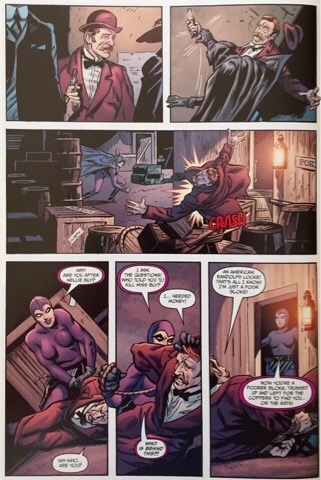
Julie Walker, the Lady Phantom, is an intriguing comic book heroine. The lineage of The Phantom goes back centuries, and is an hereditary crime-fighting and justice-seeking heroic role. Usually it is the eldest male of the line who becomes the mysterious masked figure, but occasionally a female will assume the purple costume and Julie Walker was the first such woman, taking on the role of Lady Phantom in the mid nineteenth century. Julie worked with her twin brother, Kit, the seventeenth Phantom, and if Kit was injured or absent, it would be Julie that assumed The Phantom mantle, as depicted in the above page. Both were born in the famed Skull Cave and received rigorous training from their father, the sixteenth Phantom, in the jungle, which equipped them with unarmed combat skills, proficiency in a range of weaponery as well all round athleticism. Like Batman and Batgirl the twins also received intellectual training making them fearsome researchers and detectives as well as street-savvy crime fighters.
Julie Walker was created as early as 1969 by Lee Falk, but it took more pro-feminist times for Lady Phantom to really receive the exposure she deserved, appearing regularly in the 2000s in Fantomen, Fantomet and Indragal comics. Walker was also known as The Ghost Who Walks for her mysterious appearance and apparently supernatural abilities.
Source: The Ghost Who Walks Fandom Wiki; with thanks to Mats Karlsson for the page displayed here.
#lady phantom#girl phantom#the ghost who walks#the phantom#Julie walker#kit walker#women in comics#fantomen comics
7 notes
·
View notes